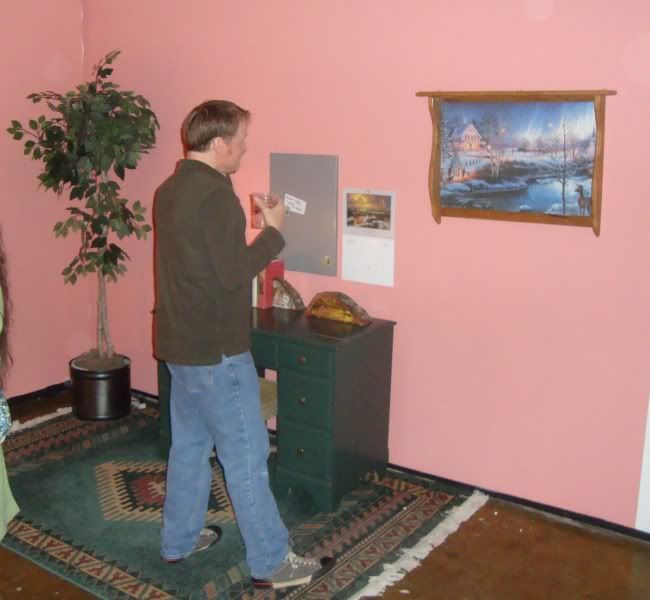Robert Boyd

Boy, that Thomas Kinkade sure does suck. He must suck, or Patricia Hernandez wouldn't go through so much trouble to create an elaborate parody of his oeuvre at Diverse Works. To be sure, Kinkade's saccharine confections are flabby and sentimental. His business empire is built on marketing kitsch to rubes. This has been obvious to everyone with a smidgen of education and taste in America. (In other words, the dreaded cultural elite that misters Beck and Hannity and O'Reilly do yeoman's work warning us against.) And, perhaps most satisfying to starving artists everywhere, Kinkade's empire is collapsing--his company, which went public in 1994 with an IPO of $110 million, entered bankruptcy in June of 2010. The self-proclaimed Christian evangelical was arrested for DUI last year and has lost several lawsuits brought against him from franchisees who say they were defrauded by the self-proclaimed "Painter of Light."

The transparent obviousness of Kinkade's awfulness, his corporatizing of art, his dreadful bad-taste-mongering, would seem to make parody or his work, well, a bit pointless. Why bother? And yet not only did Patricia Hernandez parody his work, she built a whole mall to do so. It is hard to imagine a more monumental waste of effort. I don't necessarily oppose kicking someone when they're down (indeed, when they are down, they're in the perfect position to be kicked), but I don't see much point.

Patricia Hernandez, Parody of Light showroom, installation, 2010
How does parody work? I grew up reading MAD magazine. About one third of MAD was free-form humor. Another third was satirical. And the remaining was parody. When I was reading it, the most popular parodies were their movie parodies, drawn by Mort Drucker. They seem pretty obvious in retrospect, but they had a great deal of power. Why? Because they were making fun of things that we 12-year-old readers were simultaneously consuming. We'd see a movie like Butch Cassidy and the Sundance Kid and read the MAD parody, "Botch Casually and the Somedunce Kid." And the parody would point out the cliches in the movie, and how illogical parts of it were, etc. It was undermining the very entertainment we were consuming--almost in real time. That's what good parody does. It speaks to the people who accept the thing being parodied as normal--and it tells them how not normal (how contrived, how ridiculous, how manufactured) it is.

Patricia Hernandez, Parody of Light branded toilet paper, installation, 2010
Parody is important. It's one of the ways we see behind the curtain. When we get used to the conventions of some form of art, parody comes along and reminds us that these conventions are there. This helps us because sometimes, those conventions can acquire status as eternal verities. These conventions can, over time, seem to have moral force. Parody is the court jester, the little boy pointing out that the emperor has no clothes. It's a key aspect of postmodernism, and is one way to achieve defamiliarization of the "normal."
But parody implies an audience. The reason that the National Lampoon Sunday Newspaper Parody and National Lampoon 1964 High School Yearbook Parody worked so brilliantly (besides the brilliance of the creators of those works, Doug Kenney, P.J. O'Rourke and John Hughes) is because everyone read the newspaper (in the late 70s) and everyone had a high school year book. They were examples of default culture for everyone who read the parodies. Their fundamental normalness and the invisibility of the conventions and assumptions that went into them made them ripe for parody--but only if the people reading the parodies were already intimately familiar with the things being parodied.
You can see where I'm going here. Hernandez isn't aiming her parody at people who otherwise are surrounded by Kinkade's kitsch. On the contrary, by placing the parody in Diverse Works, she is hitting a sophisticated, art-savvy audience that already knows that Kinkade is a charlatan and that his art is kitsch. Her work can't defamiliarize Kinkade's art because we already can see the strings Kinkade is using to manipulate his viewers. The revelatory aspect of parody is entirely absent.

Patricia Hernandez, A Perfect Day, oil painting, 2010
What are we left with, then? Nothing pretty. Hernandez writes "The face of the clown [whom she has inserted into the paintings] remains unseen because it has no single identity. It's a stand-in for Kinkade, his audience, how the public often perceives artists, or in a couple of images, for me." [Emphasis added.] So in the end, this whole endeavor becomes another opportunity for sophisticated, educated people to make fun of the bad taste of poor people. It's a little like that website, People of Walmart. It's funny, but I feel uncomfortable laughing at the tastelessness and cluelessness of the working class. And that's what I feel like Hernandez is doing. Making fun of the rubes.

Patricia Hernandez, Leap Through a Void, oil painting, 2010
On February 26, Diverse Works will be selling the various "Parody of Light" branded objects to benefit something called Studio One Art Resources, which is a nonprofit formed by Hernandez to help Houston's alternative art spaces establish archives--a very worthy and needed project.




No comments:
Post a Comment